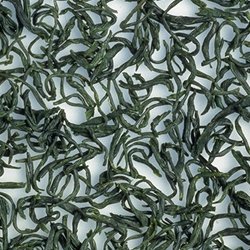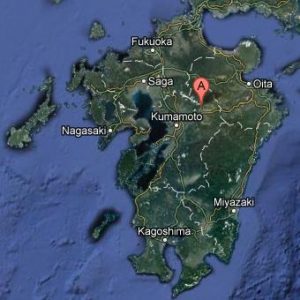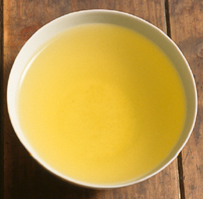 Tamaryokucha (玉緑茶, ball green tea) has a different shape than most Japanese green teas. Instead of straight leaves, they are round and curly.
Tamaryokucha (玉緑茶, ball green tea) has a different shape than most Japanese green teas. Instead of straight leaves, they are round and curly.
This tea has a mellow flavor, with light astringency, and when brewed it gives off a yellow tone.
How is tamaryokucha made?
The cultivation method and the processing is the same as for sencha, except in the last step. Instead of the tea leaves being rolled and straightened out, they are placed in a revolving drum and dried with hot air.
Actually, there are two types of tamaryokucha, the first one is steamed (just like most Japanese green teas) and the second one is pan fried (a Chinese process). Pan fried tamaryokucha is known as kamairi tamaryokucha(釜炒り玉緑茶).
The term tamaryokucha by itself refers to the steamed version, and is also called mushiguri (蒸しグリ) and guricha (ぐり茶).
 Tamaryokucha producing regions
Tamaryokucha producing regions
Tamaryokucha is mostly produced in Kyushu (a southwestern island of Japan), especially in the prefectures of Saga, Nagasaki, and Kumamoto.
Tamaryokucha was exported to the Soviet Union and the Middle East, because they preferred the shape of Chinese teas. Nowadays, I’m not sure how the state of that market is.
 How to brew tamaryokucha
How to brew tamaryokucha
Tamaryokucha is brewed using the same method as for sencha, with the water temperature of 80 °C (176 °F).
For each cup, use a teaspoon of tamaryokucha (4 grams), 60 ml of water at 80 °C (176 °F), and brew for 1 minute.

November 16, 2013
Great, informative website and postings. We just returned from a tea trip via JETRO and your website is giving us a lot of fill-in background information. I need to spend more time cruising it and soaking up information. Thank you so much!
April 25, 2014
“For each cup, use a teaspoon of tamaryokucha (4 grams), 60 ml of water at 80 °C (176 °F), and brew for 1 minute.”
This would make roughly 60g for a litre of tea while I am using about 8 to 10g for this amount of water. Are you sure your indication is correct?
Best wishes
Oliver
April 25, 2014
Hello Oliver
Yes, the guidelines are correct, it’s normal for many Japanese teas to use 4 grams per serving. These amounts are commonly used in Japan, that’s why the water volume seems low (Japanese tea cups are smaller than Western cups).
However, they aren’t set in stone. Feel free to brew your tea the way that you enjoy it best.
August 26, 2018
Of course 60g for a 1 liter of tea will be way too big… This “proportion” is not linear, so if You want to brew more tea (like 1 liter) You should use fewer leaves. Best way is to experiment. For example: make two tea: one “standard” 4g/60ml (our original taste) and the second with bigger proportion (e.g 13g/1L) . Then compare the taste and change proportion to make best result.
Cheers!
August 26, 2018
The high leaf to water ratio takes into account that you will be making multiple infusions.
So for example if you don’t need more than a liter, you can make three infusions of this tea in a tea pot that holds 360 ml (a common size for many kyusus) using 24 grams of tea.
If you will not re-infuse it, like for example for a cold brewed tea, then yes, you can use much less grams of tea and a higher amount of water.
Take a look at the following post: https://www.myjapanesegreentea.com/western-versus-japanese-style-tea-brewing
September 3, 2019
Hi, I know generally better chinese green teas because I have chinese origine.
Now, I am more and more interested in japanese tea.
I just bought a Tamaryokucha from Ureshino (the cultivar is unknown, it’s a steamed Tamryokucha, not a pan-fried one), in a Tea store in Paris
I tried to brew it in the following method after having read your guide: I put 4.7 grams in a Gaiwan of 100 ml, and brewed it for 60 seconds. The infusion was extremely bitter. As you know, the chinese brew most of their green tea like Long Jing or Biluochun in a quantity of 3.5 grams for only 15-20 seconds for the first infusion in a Gaiwan. 4 grams/60ml/ 60 seconds seems to me, a guy who is used to drink chinese green tea, a extremely bitter infusion.
I would like to know more of your opinion, does it mean the japanese green teas are generally more bitter than the chinese green teas?
September 3, 2019
Hi Eugene, thanks for your comment.
Japanese teas are more delicate to prepare in the sense that they can turn bitter quickly if one isn’t careful.
For example, you aren’t telling me what temperature you used. Make sure that it’s 80 C, lower is also good, like 70 C.
Excessive bitter flavor is undesirable in any tea, you’re right. Also astringency plays a role, a lot of astringency is undesirable as well.
You can adjust it to your taste too, don’t be afraid to experiment. Maybe try less amount of tea, and a shorter infusion.
September 3, 2019
Thank you Ricardo for your reply,
I forgot to mention the temperature, I followed your advice, so I brewed the tea at 80 °C. So the this is what I have done: 4,7 grams/ 100ml /80°C/ 60 seconds. I used a porcelaine Gaiwan so that I could have a more neutral taste. ( I used my Kyusu for my chinese teas since long time and my Yixing Teapot for Oolong teas, I don’t want them to have an influence on the infusion of this japanese tea, which I just tasted for the first time ). the Infusion was a bit too bitter for me. I will try to brew it maybe in a more chinese way. 3.5 grams/100ml/80°C/ 20 seconds for the first infusion, maybe it suits me better. Again, thank you for your answer.
Cordially,
Eugène
August 12, 2024
Infusioni multiple di Tamaryokucha:
5 grammi/150 ml.
3 infusioni
prima infusione: 70°per 60″
seconda ” : 70°per 90″
terza ” : 80°per 100″